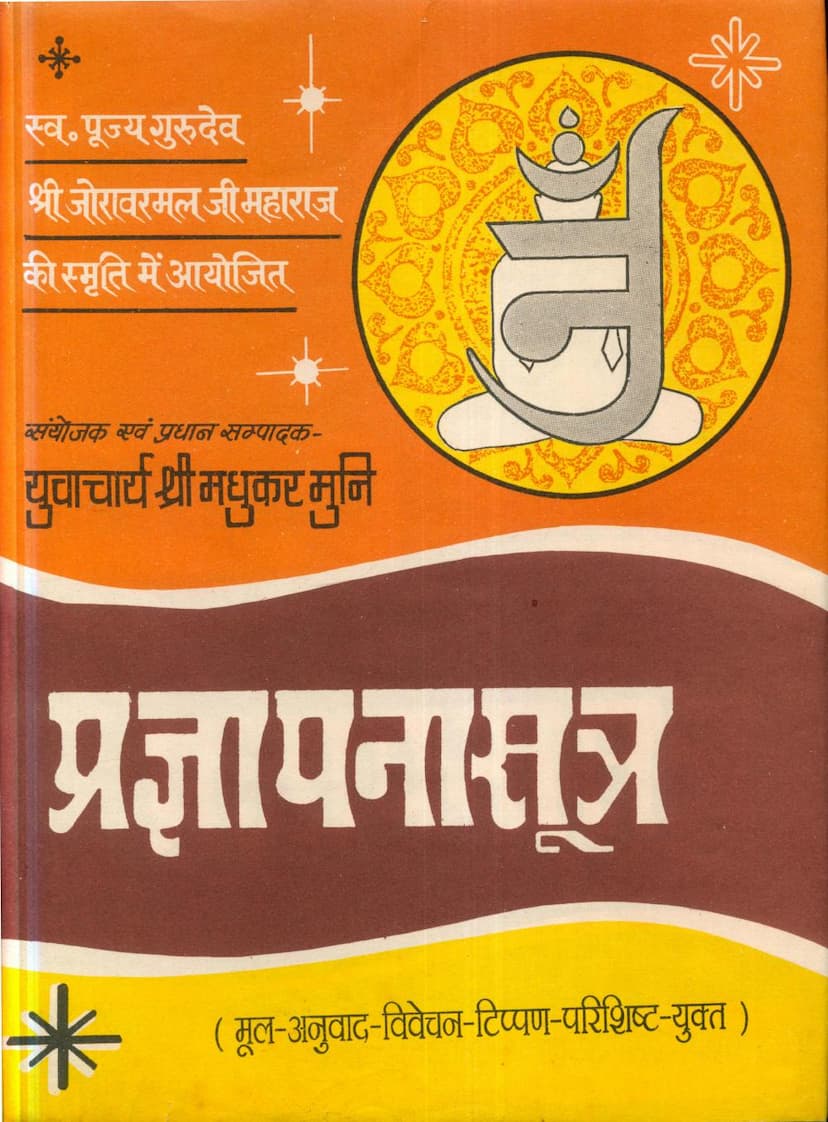Agam 15 Upang 04 Pragnapana Sutra Part 01 Stahanakvasi
Added to library: September 1, 2025

Summary
The provided text is the first part of the Pragnapana Sutra, the fourth Upanga of the Jain Agamas, compiled and translated by esteemed scholars and monks of the Jain tradition. This volume, Part 1, covers Pads 1 to 9 of the original text and includes a Hindi translation, commentary, and annotations. The publication is dedicated to the memory of the revered Guru Shri Joravarmalji Maharaj and inspired by the teachings of the Jain Jain-Divaakar Shraman Sangh's first Acharya, Pujya Shri Atmaramji Maharaj.
The text begins with a dedication, followed by a preface explaining the committee's vision to publish the Agamas with pure original text, Hindi translation, and comprehensive explanations to make them accessible to the general public and seekers of Jain philosophy. It acknowledges the crucial role of the Agamas in understanding Jain principles and the lineage of scholars who have dedicated themselves to their preservation and propagation.
The introduction delves into the importance and significance of the Pragnapana Sutra within the Jinagam Granthamala. It explains the name "Pragnapana" as deriving from Lord Mahavir's exposition of all substances and principles, and highlights its profound philosophical depth, often referenced in other Angas like the Bhagavati Sutra. The text also touches upon the concept of "Pragna" (wisdom) in Jainism, differentiating it from mere intellect and emphasizing its attainment through ascetic practices.
The summary then systematically outlines the content covered in the first nine "Pads" (sections) of the Pragnapana Sutra. Each Pad's theme is briefly introduced, indicating its significance in the comprehensive exposition of Jain philosophy. The summaries of the initial Pads are as follows:
-
Pad 1: Pragnapana (Introduction): This section defines Pragnapana itself and categorizes it into two types: Jiva (soul) Pragnapana and Ajiva (non-soul) Pragnapana. It further details Ajiva Pragnapana into Rupa (form) and Arupa (formless) categories, elaborating on the ten aspects of Arupa Ajiva (Dharmastikaya, its space-points and regions, Adharmastikaya, its space-points and regions, Akashastikaya, its space-points and regions, and Kalaguna-dravya/time) and the four aspects of Rupa Ajiva (Skandhas, Skandha-desha, Skandha-pradesha, and Parmanu-pudgal). It further breaks down Rupa Ajiva based on color, odor, taste, touch, and form, detailing various permutations and combinations. For Jiva Pragnapana, it distinguishes between Samsari (worldly) and Siddha (liberated) souls, enumerating the fifteen types of liberated souls and classifying worldly souls based on their senses (from ekendriya to panchendriya).
-
Pad 2: Sthan (Location/Abode): This Pad discusses the abodes of living beings. It classifies abodes into two types: Svasthan (permanent abode) and Prasangik (situational abode), which further includes Upapata (new birth) and Samudghata (projection of soul-body). It then details the locations of various categories of beings, including the seven hellish earths, various types of heavens (from Bhavavasi to Vaimanika), and the abodes of different types of Jivas like Prithvikayika (earth-bodied), Jivakayika (water-bodied), Tejaskayika (fire-bodied), Vayukayika (air-bodied), Vanaspatikayika (plant-bodied), and Trassakayika (mobile beings). It elaborates on the specifics of these locations and the beings residing in them.
-
Pad 3: Bahuvaktavya (Classification based on quantity/multiplicity): This Pad focuses on the quantitative aspect of living beings. It delves into the concept of Alpabahutva (fewer or more) based on various classifications such as directions, existence of body (kaya), senses, consciousness (samjnin/asamjnin), lifespan, psychological states (kashaya, leshya), stages of spiritual development (drushti, samyama), knowledge (jnana), faith (darshana), soul-activity (yoga), origin (yoni), and the finality of life-cycle (charam/acharama). It also covers the multiplicity of Pudgala (matter) in its various forms (parmanu, skandha) based on their attributes and time duration.
-
Pad 4: Sthiti (Lifespan/Duration): This Pad deals with the lifespan of different categories of beings. It provides the minimum (jaghanya) and maximum (utkrishta) lifespan for various beings, including hell-dwellers (Nairayikas) in the seven hellish earths, Bhavanavasis, and other celestial beings, as well as the subtle and gross forms of the five elements (prithvi, ap, tejas, vayu, vanaspati) and their respective lifespans.
The text meticulously details the classification of beings and their abodes and lifespans, reflecting the Jain emphasis on comprehensive and nuanced understanding of the universe and the beings within it. The inclusion of concepts like "aparyapta" (incomplete development) and "paryapta" (complete development) further highlights the intricate classification system used in Jain cosmology. The introduction and the detailed descriptions of each Pad lay the groundwork for understanding the complex philosophical and cosmological framework of Jainism presented in the Pragnapana Sutra.